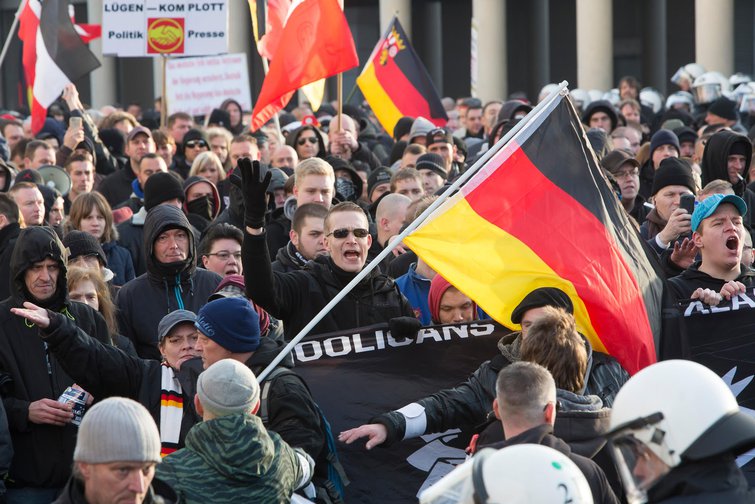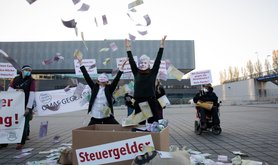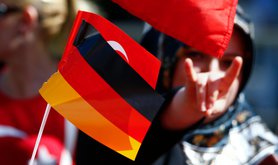
How the German far Right appropriates ideals of non-violent resistance
The far Right’s claims to be ‘peaceful Europeans’ are absurd, especially in the light of increasingly violent anti-lockdown protests

Pegida, the largest far-Right movement in Germany, was founded in Dresden in 2014 under the name ‘Peaceful Europeans against the Islamisation of the Occident’. The group has regularly mobilised thousands of supporters for what it calls “peaceful marches” in the heart of this former East German city. These demonstrations express typical far-Right ideology, including the degradation of immigrants and the ‘leftist’ mainstream in media and politics.
Even though Pegida soon changed ‘peaceful Europeans’ to ‘patriotic Europeans’, the original name said it all. Pegida sees itself as a peaceful and non-violent resistance force in an imagined fight against what it perceives as an all-encompassing left-wing “opinion dictatorship” in Germany.
To symbolically flesh out its claim, Pegida usually stages its events near the Frauenkirche, the famous Baroque church that was almost completely destroyed by Allied bombing in the Second World War, finally rebuilt after German reunification and is now a global symbol of peace and reconciliation. Among the crowds, one can easily spot well-known peace symbols such as the dove and the 1980s German slogan about turning swords into ploughshares. No march is complete without the organisers praising themselves for “another peaceful and non-violent event".
‘Opinion dictatorship’
It’s not just Pegida: the idea – and ideal – of non-violence has become a powerful trope in contemporary far-Right thought in Germany. For instance, the Institute for State Politics (IfS), the country’s major far-Right think tank, regularly includes articles on the concept of non-violent resistance in its in-house journal Sezession. In 2017, it even hosted a conference on the subject, targeted at far-Right youth involved in the Identitarian Movement within the Alternative for Germany (AfD) party’s youth organisation.
We’ve got a newsletter for everyone
Whatever you’re interested in, there’s a free openDemocracy newsletter for you.
According to Martin Sellner, leader of the Identitarian Movement of Austria (IBO) and a guest speaker at the conference, non-violent resistance must be the key strategy for the far Right to overcome what he calls the Left’s “opinion dictatorship”.
Since this supposedly totalitarian system suppresses the Right via cultural hegemony, the right-wing resistance needs to beat the system at its own game – that is, with ideas rather than violence. Sellner calls for symbolic forms of protest, such as the Identitarian Movement’s much mediatised action at Berlin’s world-famous Brandenburg Gate in 2015, or the various ‘Defend Europe’ missions in the Alps, Pyrenees and Mediterranean Sea.
Searching for intellectual depth, Sellner appropriates the classic emancipatory political thinker – the late American political philosopher Gene Sharp (1928–2018). Sharp’s works on non-violent struggle inspired pro-democratic resistance movements across the world for several decades, including the 1989 East German Peaceful Revolution against the communist dictatorship.
In an article for the IfS’s journal in 2017, Sellner uses Sharp’s writings to elaborate on the supposed parallels between Germany’s ‘leftist totalitarianism’ and military dictatorships around the world. He also claims that “For our action against the leftist education dictatorship, Sharp’s guide for liberation does not need to be appropriated by us – it was written for us.”
At one Pegida rally, a mock gallows was ‘reserved’ for Chancellor Angela Merkel
The hypocrisy of such claims of non-violence is clear. True, violent confrontations with counter-demonstrators, people of colour or journalists are rare at Pegida’s protests. Yet (as Manès Weisskircher and I show in the 2021 ‘Routledge Handbook of Non-violent Extremism’), Pegida oscillates between radical and extremist ideology.
A mock gallows “reserved for” German Chancellor Angela Merkel, prominently displayed at an anti-Islam demonstration in 2015, revealed Pegida’s extremist tendency to symbolically exercise violence from the outset.
Over the years, speakers at Pegida’s rallies have been repeatedly accused – and occasionally convicted – of abusive speech and rabble-rousing, both on social media and on the squares of Dresden.
In 2019, several people pressed charges against Pegida’s leader, Lutz Bachmann, for a speech in which he verbally abused Green Party members and trade unionists as “vermin of the people”, “asocial maggots” and “parasites”. He said Pegida supporters should “throw [them] into a ditch” and then “fill up the ditch”.
Anti-lockdown protests and the Reichsbürger
Far-Right claims about non-violence seem particularly absurd when it comes to the wave of anti-lockdown protests held across the country during the COVID-19 pandemic.
The notion of peace is common at these often ideologically ambiguous demonstrations. Protesters frequently call for the adoption of a peace treaty between Germany and the victors of the Second World War (namely, the United States, Great Britain, France and Russia as the successor state of the former Soviet Union).
A popular political myth holds that – because no formal peace treaty was signed at the end of the war – the contemporary Federal Republic of Germany is still occupied by the victorious Allies and is not a sovereign state.
For years, this myth has been propagated by the far-Right Reichsbürger movement, an umbrella term for individuals and loosely organised groups who deny or question the existence of the Federal Republic and claim to be citizens of the pre-war German Reich. They reject the German democratic system and the civic duties that come with it, such as paying taxes and fines.
These so-called ‘sovereign citizens’ tend to own arms and can be physically violent. Most importantly, a member of the Reichsbürger movement assassinated leading politician Walter Lübcke in 2019.
Such individuals and groups have become increasingly visible in anti-lockdown mobilisation. Notably, on 29 August 2020, after a large-scale protest in the centre of Berlin, several hundred demonstrators, including Reichsbürger, broke through the security barriers at the Reichstag. In an action similar to that at the US Capitol in January 2021, they staged a symbolic ‘storming’ of the parliament building. An anti-lockdown demonstration in Leipzig was also followed by violent rioting by the far Right in November 2020.
Claims of non-violent resistance by the far Right are mere rhetoric or means to an end. Germany must be more alert to prevent actual physical violence and to protect the safety of parliamentarians, the representatives of democracy, but must also recognise the dangers of symbolic violence.
This research is part of a project that has received funding from the European Union’s Horizon 2020 research and innovation programme under grant agreement No. 765224.
Read more
Get our weekly email






Comments
We encourage anyone to comment, please consult the oD commenting guidelines if you have any questions.